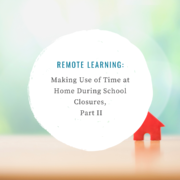Executive Functioning & Distance Learning: Part I
As educators and mental health professionals, helping students manage their executive functioning is a critical aspect of building the foundation for academic, social, and emotional success. For neuroatypical students, particularly those with ASD and ADHD, addressing executive functioning skills within the classroom setting is already challenging enough. However, with current hybrid models and distance learning, these students are struggling even more to adapt.
Background info for educators
Executive functioning is often thought of as the “management center of the brain” or the control center of thinking. Our executive functioning assists with many different cognitive skills, which is why it not only impacts students academically, but also socially, emotionally, and physically. Some skills associated with executive functioning include: attentiveness, self-monitoring and regulating, emotional/impulse control, organizational skills, ability to prioritize, perspective taking, and planning/chunking larger tasks into smaller pieces. Many of these skills help us to perform tasks throughout our entire lives. Therefore, executive dysfunction can have a lifelong impact on students beyond their capabilities in the classroom.
What does executive dysfunction look like?
Difficulties concerning executive functioning vary from person to person and also differ in severity. Common examples of ways in which students exhibit executive dysfunction include:
- Avoiding tasks or struggling to initiate an assignment
- Procrastinating; trouble with managing time
- Difficulty prioritizing tasks or steps in a process
- Misplacing things
- Struggling to put thoughts on paper; difficulty explaining oneself
- Difficulty transitioning between tasks or moving from one activity to another
- May struggle to follow directions or to complete steps in chronological order
- May exhibit a preoccupation with a small detail of the task; i.e. missing the big picture
- Difficulty with working memory; they may forget what they heard or read
- May struggle when schedules, rules, procedures, or expectations change; i.e. exhibit a level of inflexibility when they’ve become used to a certain routine
Providing assistance with these struggles in the classroom is much easier; educators are physically there in person to alleviate issues and help students to troubleshoot their individual challenges. In the classroom, we have the ability to personally connect with students and provide them with necessary supports and accommodations, like check-ins, checklists, organizers, etc. Now, with distance learning, students with executive dysfunctions are not necessarily getting the same level of support and attention. We can fix this, however, with a little creativity—and a lot of patience!
Strategies for teachers during distance learning
Here are a few tips for supporting students with executive functioning issues:
- Assess: Take inventory of your students’ needs and tendencies. I began the school year by asking every student which part of the writing process he/she hates the most. Do they struggle to begin writing? Drafting? Organizing a cohesive argument/essay? Revising? Getting thoughts down on paper? For students who said that they find it difficult to get started, I provided several supports.
- Model: Firstly, every writing task that I ask students to do, I also complete and spend one class period reading my draft and discussing my writing process. Seeing an example of what the final task should look like is beneficial for all students, but especially those who struggle to initiate writing and to see the big picture. During this “modeled writing session,” I ask students to tell me what they notice about the sample. Their answers provide me with insight into how they interpret the assignment, which allows me to see who really needs greater scaffolds and who does not.
- Specify: Secondly, when students disclose that getting ideas onto paper is their greatest challenge, I provide them with very specific, thoroughly broken down organizers with sentence starters. This removes the “getting started” barrier and gives them a jumpstart to initiate the task with some momentum.
- Organize: Finally, for my students who struggle to piece together their writing (organize and revise), I find it helpful to color-coordinate the different aspects of the essay or paragraph. For example, I may highlight students’ thesis statements in red, transition words in blue, evidence/quotes in green, and analysis in orange. When reading through a student’s draft, I can easily direct them to certain sections with specific instructions to add more orange, for instance. This tells them immediately that their paper is lacking sufficient analysis. It also tells them where that analysis or orange should be placed so that the guesswork is gone.
- Check-in: Another best practice that we regularly use in the classroom is to chunk larger assignments and include check-ins throughout the project or essay. With distance learning, I’ve found that breakout rooms in Zoom allow for me to specifically check in with each student during a writing work session. The platform allows students to share their screen with me 1:1 so that I can check their progress individually. This practice also allows me to see who is far behind in terms of completion. The check-ins prompt students to set small goals while working, but they also allow enough time for me to intervene if a task looks like it’s falling to the wayside.






